Fabrication and Applications of Potentiometric Membrane Sensors Based on γ-Cyclodextrin and Calixarene as Ionophores for the Determination of a Histamine H1-Receptor Antagonist: Fexofenadine
Abstract
:1. Introduction
2. Experimental Section
2.1. Apparatus
2.2. Reagents and Materials
2.3. Preparation of Fexofenadine Sensors
2.4. Procedure
2.5. Determination of Fexofenadine in Dosage Form
2.6. Pharmacopeia Method
2.7. Potentiometric Titration
3. Results and Discussion
3.1. Effect of Additive
3.2. Formation Constant
3.3. Effect of Plasticizers
3.4. Interferences Studied
3.5. Effect of pH, Response Time, and Soaking Time
3.6. Sensors Characteristics
3.7. Accuracy and Precision
3.7.1. Ruggedness
3.7.2. Robustness
3.8. Application
Application of Fexofenadine Sensors as the Indicator Electrode
4. Conclusions
Author Contributions
Funding
Institutional Review Board Statement
Informed Consent Statement
Data Availability Statement
Acknowledgments
Conflicts of Interest
Sample Availability
References
- Ashwin, B.C.M.A.; Shanmugavelan, P.; Muthu Mareeswaran, P. Electrochemical Aspects of Cyclodextrin, Calixarene and Cucurbituril Inclusion Complexes. J. Incl. Phenom. Macrocycl. Chem. 2020, 98, 149–170. [Google Scholar] [CrossRef]
- Bühlmann, P.; Chen, L.D. Ion-Selective Electrodes with Ionophore-Doped Sensing Membranes. Supramol. Chem. Mol. Nanomater. 2012, 5, 2539. [Google Scholar]
- Ghale, G.; Nau, W.M. Dynamically Analyte-Responsive Macrocyclic Host–Fluorophore Systems. Acc. Chem. Res. 2014, 47, 2150–2159. [Google Scholar] [CrossRef] [PubMed]
- Pinalli, R.; Pedrini, A.; Dalcanale, E. Biochemical Sensing with Macrocyclic Receptors. Chem. Soc. Rev. 2018, 47, 7006–7026. [Google Scholar] [CrossRef] [PubMed]
- Braegelman, A.S.; Webber, M.J. Integrating Stimuli-Responsive Properties in Host-Guest Supramolecular Drug Delivery Systems. Theranostics 2019, 9, 3017. [Google Scholar] [CrossRef] [PubMed]
- Mako, T.L.; Racicot, J.M.; Levine, M. Supramolecular Luminescent Sensors. Chem. Rev. 2018, 119, 322–477. [Google Scholar] [CrossRef]
- Chinta, J.P.; Acharya, A.; Kumar, A.; Rao, C.P. Spectroscopy and Microscopy Studies of the Recognition of Amino Acids and Aggregation of Proteins by Zn (II) Complex of Lower Rim Naphthylidene Conjugate of Calix [4] Arene. J. Phys. Chem. B 2009, 113, 12075–12083. [Google Scholar] [CrossRef]
- Liu, S.; Luo, Z.; Hamilton, A.D. Rapid and Highly Selective Cleavage of Ribonucleoside 2′, 3′-Cyclic Monophosphates by Dinuclear Cuii Complexes. Angew. Chem. Int. Ed. Engl. 1997, 36, 2678–2680. [Google Scholar] [CrossRef]
- Challa, R.; Ahuja, A.; Ali, J.; Khar, R.K. Cyclodextrins in Drug Delivery: An Updated Review. AAPS Pharmscitech. 2005, 6, E329–E357. [Google Scholar] [CrossRef]
- Wang, Q.; Zhang, A.; Zhu, L.; Yang, X.; Fang, G.; Tang, B. Cyclodextrin-Based Ocular Drug Delivery Systems: A Comprehensive Review. Coord. Chem. Rev. 2023, 476, 214919. [Google Scholar] [CrossRef]
- Crini, G.; Morcellet, M. Synthesis and Applications of Adsorbents Containing Cyclodextrins. J. Sep. Sci. 2002, 25, 789–813. [Google Scholar] [CrossRef]
- Mura, P. Analytical Techniques for Characterization of Cyclodextrin Complexes in Aqueous Solution: A Review. J. Pharm. Biomed. Anal. 2014, 101, 238–250. [Google Scholar] [CrossRef]
- Mokhtari, B.; Pourabdollah, K.; Dalali, N. Analytical Applications of Calixarenes from 2005 Up-to-Date. J. Incl. Phenom. Macrocycl. Chem. 2011, 69, 1–55. [Google Scholar] [CrossRef]
- El Nashar, R.M.; Wagdy, H.A.A.; Aboul-Enein, H.Y. Applications of Calixarenes as Potential Ionophores for Electrochemical Sensors. Curr. Anal. Chem. 2009, 5, 249–270. [Google Scholar] [CrossRef]
- Kuna, P.; Jurkiewicz, D.; Czarnecka-Operacz, M.M.; Pawliczak, R.; Woroń, J.; Moniuszko, M.; Emeryk, A. The Role and Choice Criteria of Antihistamines in Allergy Management–Expert Opinion. Alergol. Pol. J. Allergol. 2017, 4, 7–19. [Google Scholar] [CrossRef] [Green Version]
- Compalati, E.; Baena-Cagnani, R.; Penagos, M.; Badellino, H.; Braido, F.; Gómez, R.M.; Canonica, G.W.; Baena-Cagnani, C.E. Systematic Review on the Efficacy of Fexofenadine in Seasonal Allergic Rhinitis: A Meta-Analysis of Randomized, Double-Blind, Placebo-Controlled Clinical Trials. Int. Arch. Allergy Immunol. 2011, 156, 1–15. [Google Scholar] [CrossRef] [PubMed]
- Dicpinigaitis, P.V.; Gayle, Y.E. Effect of the Second-generation Antihistamine, Fexofenadine, on Cough Reflex Sensitivity and Pulmonary Function. Br. J. Clin. Pharmacol. 2003, 56, 501–504. [Google Scholar] [CrossRef] [Green Version]
- Rele, R. UV Spectrophotometric Estimation of Fexofenadine Hydrochloride by First Order Derivative and Area under Curve Methods in Bulk and Pharmaceutical Dosage Form. Der. Pharm. Lett. 2016, 8, 95–101. [Google Scholar]
- Ramzy, S.; Abdelazim, A.H.; Hasan, M.A. Application of Green First Derivative Synchronous Spectrofluorometric Method for Quantitative Analysis of Fexofenadine Hydrochloride and Pseudoephedrine Hydrochloride in Pharmaceutical Preparation and Spiked Human Plasma. BMC Chem. 2022, 16, 62. [Google Scholar] [CrossRef]
- Golcu, A.; Dogan, B.; Ozkan, S.A. Anodic Voltammetric Behavior and Determination of Antihistaminic Agent: Fexofenadine HCl. Anal. Lett. 2005, 38, 1913–1931. [Google Scholar] [CrossRef]
- Karakuş, S.; Küçükgüzel, İ.; Küçükgüzel, Ş.G. Development and Validation of a Rapid RP-HPLC Method for the Determination of Cetirizine or Fexofenadine with Pseudoephedrine in Binary Pharmaceutical Dosage Forms. J. Pharm. Biomed. Anal. 2008, 46, 295–302. [Google Scholar] [CrossRef] [PubMed]
- Konieczna, L.; Plenis, A.; Olędzka, I.; Kowalski, P.; Bączek, T. Rapid RP-LC Method with Fluorescence Detection for Analysis of Fexofenadine in Human Plasma. Chromatographia 2010, 71, 1081–1086. [Google Scholar] [CrossRef]
- Li, M.; Zhang, J.; Ma, S.; Jiang, Z.; Di, X.; Guo, X. Chiral Separation of Five Antihistamine Drug Enantiomers and Enantioselective Pharmacokinetic Study of Carbinoxamine in Rat Plasma by HPLC-MS/MS. New J. Chem. 2020, 44, 5819–5827. [Google Scholar] [CrossRef]
- AlRabiah, H.; Abounassif, M.; Aljohar, H.I.; Mostafa, G.A.-H. New Potentiometric Sensors for Methylphenidate Detection Based on Host–Guest Interaction. BMC Chem. 2019, 13, 121. [Google Scholar] [CrossRef] [Green Version]
- Almalik, A.; Alrabiah, H.; Ghabbour, H.; Abounassif, M.; Mostafa, G.A.-H. Beta-and Gamma-Cyclodextrin Ionophores as Electroactive Materials for Construction of New Polyvinyl Chloride Sensors for Eletriptan Based on Host-Guest Recognition. Mater. Express 2018, 8, 182–188. [Google Scholar] [CrossRef]
- Nashed, D.; Noureldin, I.; Sakur, A.A. New Pencil Graphite Electrodes for Potentiometric Determination of Fexofenadine Hydrochloride and Montelukast Sodium in Their Pure, Synthetic Mixtures, and Combined Dosage Form. BMC Chem. 2020, 14, 60. [Google Scholar] [CrossRef] [PubMed]
- Sakur, A.A.; Nashed, D.; Noureldin, I. Green Potentiometric Determination of Some of the Third-Generation Antihistamines: Fexofenadine, Desloratadine, and Levocetirizine by Using New Carbon Paste Electrodes. Talanta Open 2022, 5, 100116. [Google Scholar] [CrossRef]
- Abass, A.M.; Hassan, O.S.; Rikabi, A.L.; Salim, H.T.H.; Ahmed, A. Potentiometric Determination of Fexofenadine Hydrochloride Drug by Fabrication of Liquid Membrane Electrodes. Egypt. J. Chem. 2021, 64, 6293–6300. [Google Scholar]
- Abbas, M.N.; Fattah, A.A.A.; Zahran, E. A Novel Membrane Sensor for Histamine H1-Receptor Antagonist “Fexofenadine”. Anal. Sci. 2004, 20, 1137–1142. [Google Scholar] [CrossRef] [Green Version]
- Al-Mohaimeed, A.M.; Alarfaj, N.A.; El-Tohamy, M.F.; Al-Harbi, H. Prospective of Ultrasenstive Nanometal Oxides Electrochemical Sensors for Pharmaceutical Analysis of Antihistamine Drug Fexofenadine Hydrochloride. Int. J. Electrochem. Sci. 2020, 15, 4774–4788. [Google Scholar] [CrossRef]
- Moody, G.J.; Thomas, J.D.R.; Lima, J.; Machado, A. Characterisation of Poly (Vinyl Chloride) Barium Ion-Selective Electrodes without an Internal Reference Solution. Analyst 1988, 113, 1023–1027. [Google Scholar] [CrossRef]
- Ortuno, J.A.; Tom´as-Alonso, F.; Rubio, A.M. Ionic Liquids in Separation Technology; Elsevier: Amsterdam, The Netherlands, 2014; pp. 275–299. [Google Scholar]
- Bakker, E. Encyclopedia of Analytical Sciences, 2nd ed.; Elsevier: Amsterdam, The Netherlands, 2005; pp. 509–514. [Google Scholar]
- Alrabiah, H.; Homoda, A.M.A.; Radowan, A.A.; Ezzeldin, E.; Mostafa, G.A.E. Polymeric Membrane Sensors for Batch and Flow Injection Potentiometric Determination of Procainamide. IEEE Sens. J. 2020, 21, 4198–4208. [Google Scholar] [CrossRef]
- AlRabiah, H.; Ezzeldin, E.; Abounassif, M.; Abdel-Hafiz Mostafa, G. PVC Sensors for Ciprofloxacin Based on Inclusion Complex with β-and γ-Cyclodextrin. Curr. Pharm. Anal. 2018, 14, 382–388. [Google Scholar] [CrossRef]
- Frömming, K.H.; Szejtli, J. Cyclodextrins in Pharmacy; Kluwer Academic Publishers: Dordrecht, The Netherlands, 1994. [Google Scholar]
- Healy, B.; Yu, T.; da Silva Alves, D.C.; Okeke, C.; Breslin, C.B. Cyclodextrins as supramolecular recognition systems: Applications in the fabrication of electrochemical sensors. Materials 2021, 28, 1668. [Google Scholar] [CrossRef] [PubMed]
- Gorski, L.; Matusevich, A.; Parzuchowski, P.; Luciuk, I.; Malinowska, E. Fluoride-selective polymeric membrane electrodes based on Zr (IV)-and Al (III)-salen ionophores of various structures. Anal. Chim. Acta 2010, 665, 39–46. [Google Scholar] [CrossRef]
- El-Kosasy, A.M.; Nebsen, M.; Abd El-Rahman, M.K.; Salem, M.Y.; El-Bardicy, M.G. Comparative Study of 2-Hydroxy Propyl Beta Cyclodextrin and Calixarene as Ionophores in Potentiometric Ion-Selective Electrodes for Neostigmine Bromide. Talanta 2011, 85, 913–918. [Google Scholar] [CrossRef] [PubMed]
- Lenik, J.; Łyszczek, R. Functionalized β-cyclodextrin based potentiometric sensor for naproxen determination. Mater. Sci. Eng. C 2016, 61, 149–157. [Google Scholar] [CrossRef]
- Qin, Y.; Mi, Y.; Bakker, E. Determination of complex formation constants of 18 neutral alkali and alkaline earth metal ionophores in poly (vinyl chloride) sensing membranes plasticized with bis (2-ethylhexyl) sebacate and o-nitrophenyloctylether. Anal. Chim. Acta 2000, 421, 207–220. [Google Scholar] [CrossRef]
- Bakker, E. Determination of unbiased selectivity coefficients of neutral carrier-based cation-selective electrodes. Anal. Chem. 1997, 69, 1061–1069. [Google Scholar] [CrossRef]
- Buck, R.P.; Lindner, E. Recommendations for Nomenclature of Ionselective Electrodes (IUPAC Recommendations 1994). Pure Appl. Chem. 1994, 66, 2527–2536. [Google Scholar] [CrossRef]
- Kumar, L.; Alam, M.S.; Meena, C.L.; Jain, R.; Bansal, A.K. Fexofenadine Hydrochloride. In Profiles of Drug Substances, Excipients and Related Methodology; Elsevier: Amsterdam, The Netherlands, 2009; Volume 34, pp. 153–192. ISBN 1871-5125. [Google Scholar]
- The Stationary Office. British Pharmacopoeia 2010; Stationery Office Books: London, UK, 2010; Volume 2. [Google Scholar]
- Miller, J.; Miller, J.C. Statistics and Chemometrics for Analytical Chemistry; Pearson Education: New York, NY, USA, 2018; ISBN 1292186747. [Google Scholar]
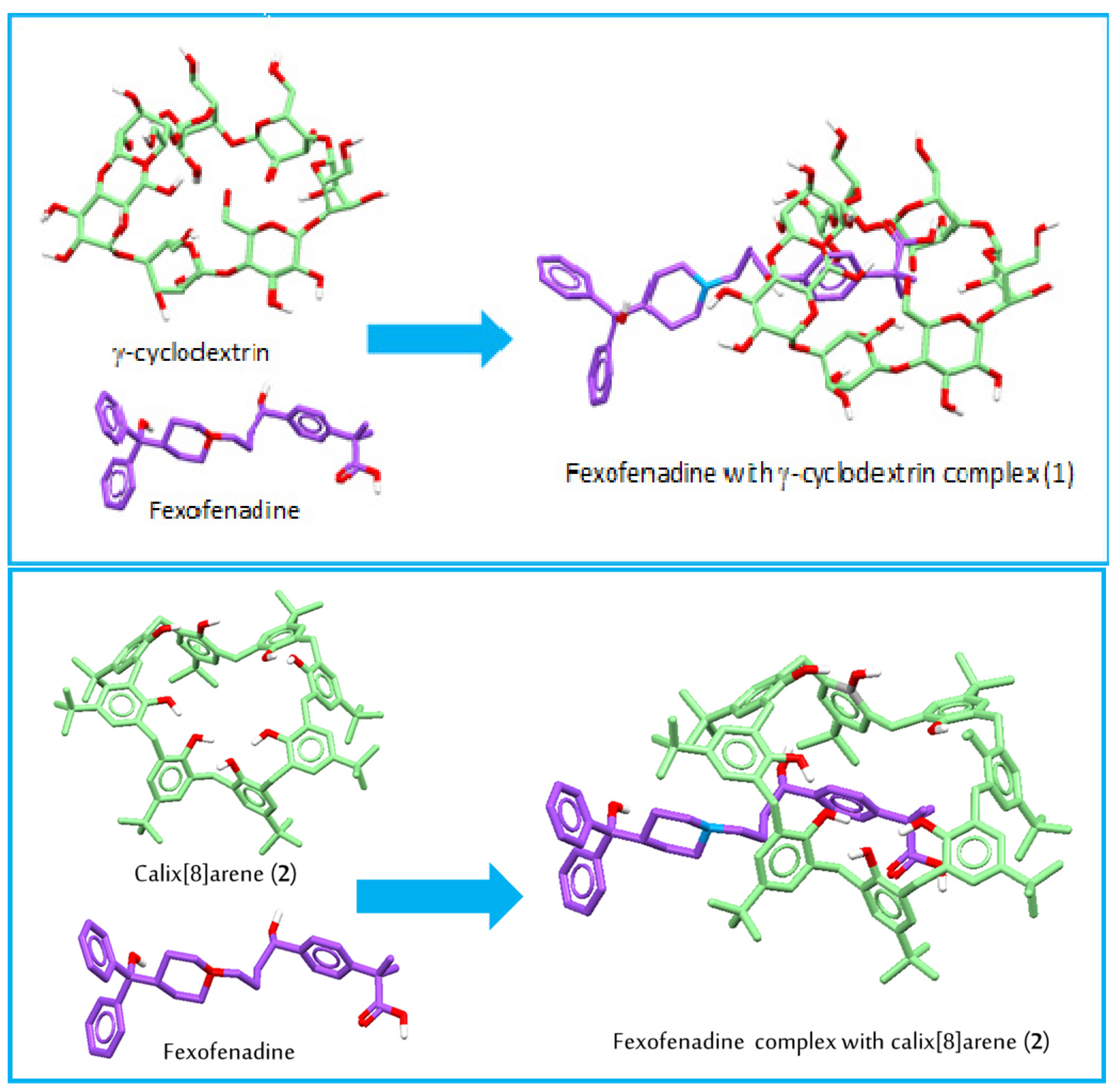
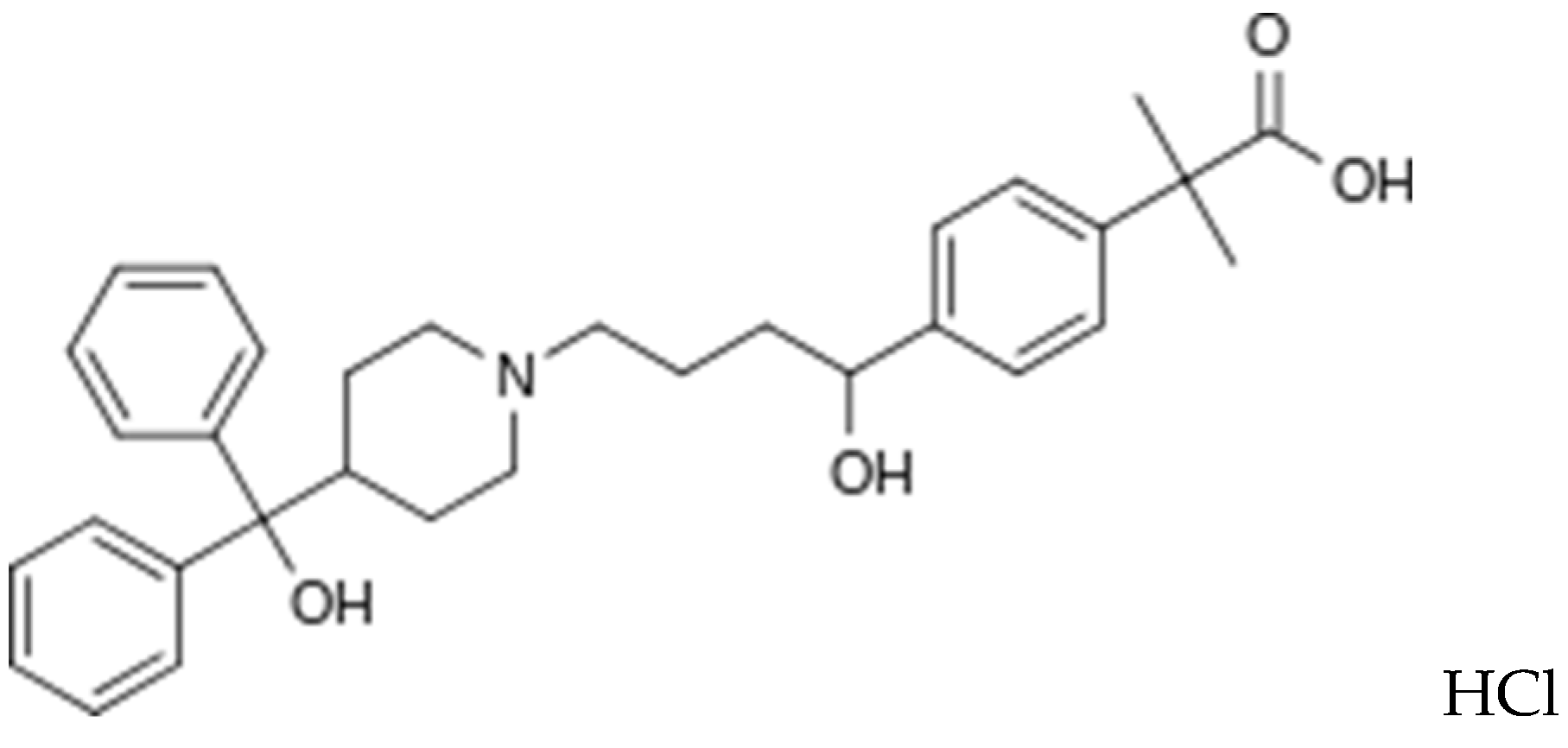

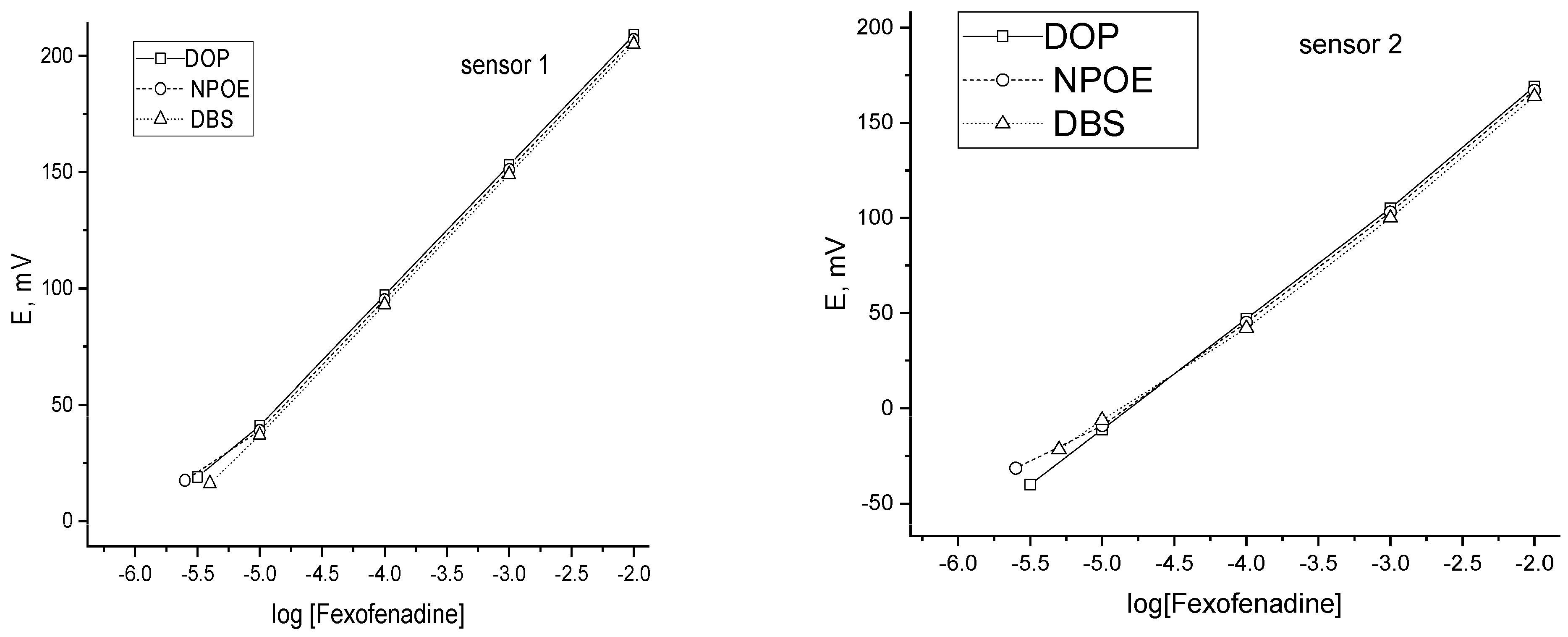

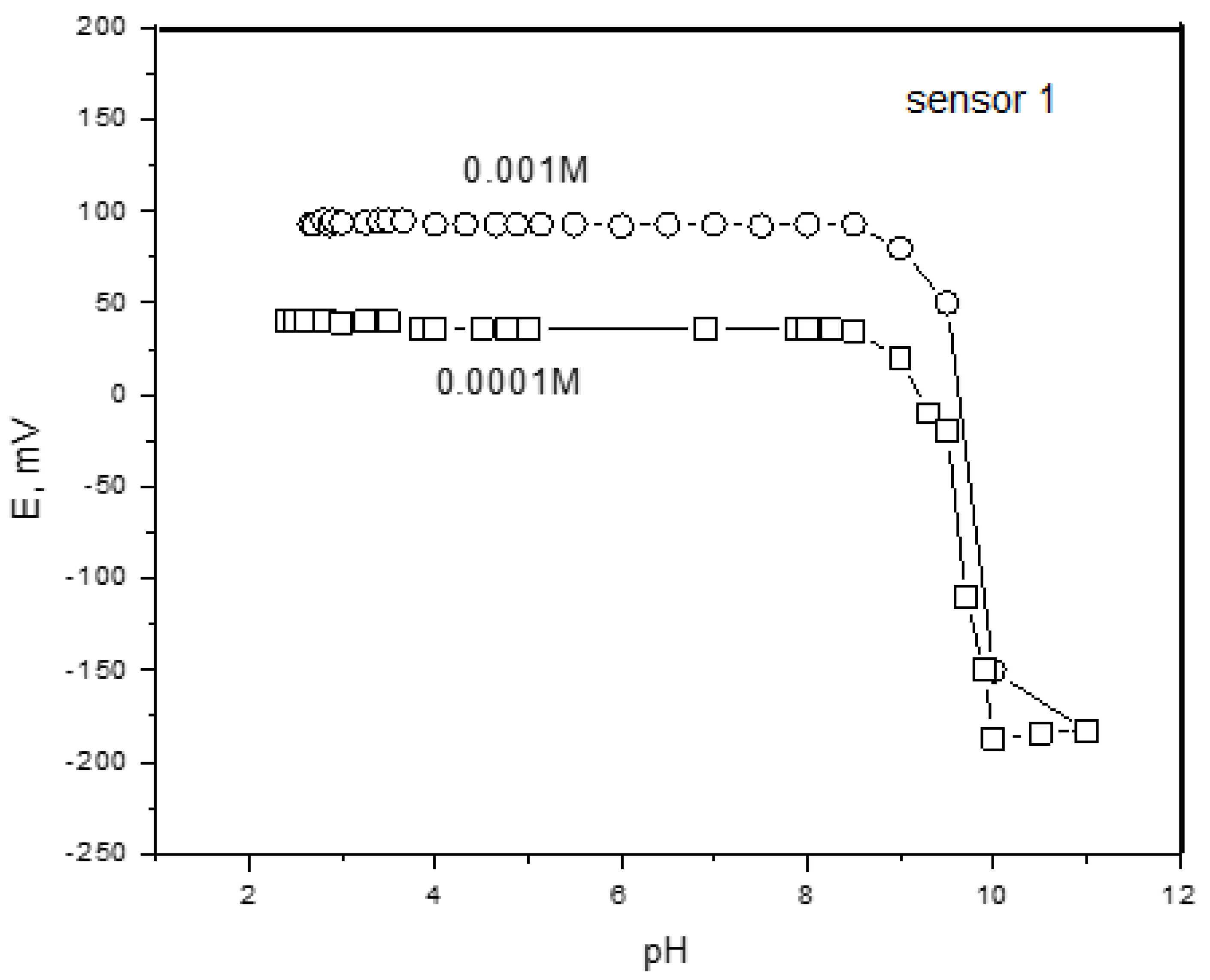



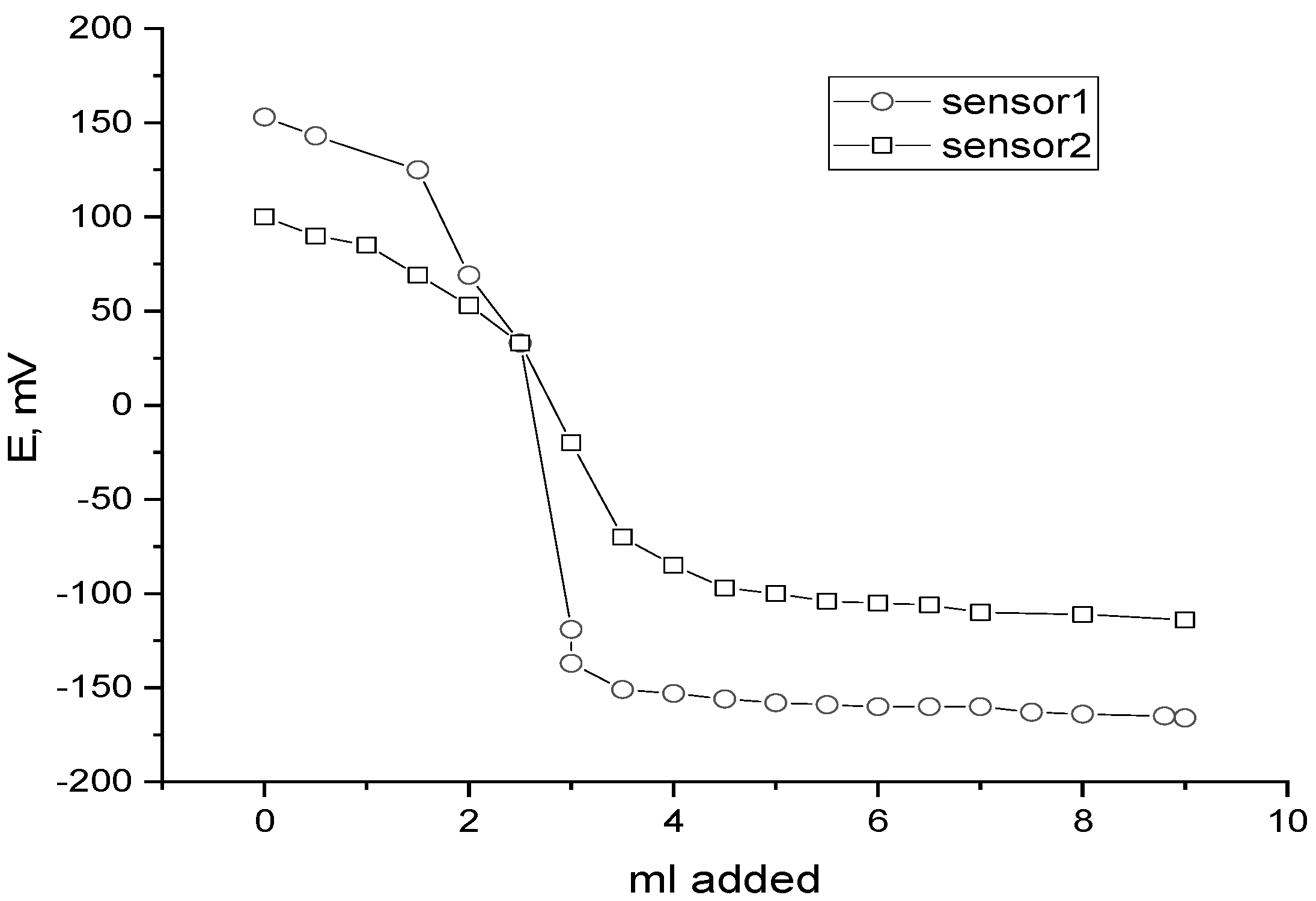
| Concentration, µM | Sensor 1 | Sensor 2 | |||
|---|---|---|---|---|---|
| Lipophilic Ion | Carrier | Slope * | Calibration Range, M | Slope * | Calibration Range, M |
| 2.01 | 7.71 | 47 ± 0.4 | 1 × 10−2–1 × 10−5 | 54 ± 0.5 | 1 × 10−2–1 × 10−5 |
| 4.03 | 7.71 | 52 ± 0.5 | 1 × 10−2–8 × 10−6 | 54 ± 0.4 | 1 × 10−2–8 × 10−6 |
| 6.05 | 7.71 | 56 ± 0.3 | 1 × 10−2–4.5 × 10−6 | 58 ± 0.4 | 1 × 10−2–4.7 × 10−6 |
| 10.07 | 7.71 | 56 ± 0.4 | 1 × 10−2–4.5 × 10−6 | 58 ± 0.3 | 1 × 10−2–4.7 × 10−6 |
| 6.05 | 0 | 43 ± 0.4 | 1 × 10−2–5 × 10−4 | 41 ± 0.4 | 1 × 10−2–5 × 10−4 |
| Plasticizer | DOP | DBS | o-NPOE |
|---|---|---|---|
| Sensor 1 | |||
| Slope (mV/decade) * | 54 ± 0.4 | 52 ± 0.5 | 56 ± 0.3 |
| Response time (s) | 15 | 20 | 15 |
| Calibration range (M) | 5 × 10−6–10−2 | 6 × 10−6–10−2 | 4.5 × 10−6–10−2 |
| Sensor 2 | |||
| Slope (mV/decad) * | 56 ± 0.4 | 53 ± 0.5 | 58 ± 0.3 |
| Response time (s) | 25 | 20 | 15 |
| Calibration range (M) | 6 × 10−6–10−2 | 7 × 10−6–10−2 | 4.7 × 10−6–10−2 |
| Interferent *, J | |||
|---|---|---|---|
| Na+ | −1.76 | −2.76 | 2.91 |
| K+ | −1.82 | −2.677 | 0.497 |
| Ca2+ | −1.85 | −2.76 | 0.171 |
| Fe2+ | −1.82 | −2.74 | 1.22 |
| Magnesium Stearate | −2.82 | −2.69 | 8.14 |
| Parameter | Sensor 1 | Sensor 2 |
|---|---|---|
| Slope, (mV decade−1) | 56 ± 0.4 | 58 ± 0.5 |
| Intercept, mV | 321 ± 0.5 | 279 ± 0.5 |
| Correlation Coefficient, (r2) | 0.998 | 0.998 |
| Calibration, rang M | 4.5 × 10−6–1 × 10−3 | 4.7 × 10−6–1 × 10−3 |
| Lower limit of quantification, (LOQ), M | 4.5 × 10−6 | 4.7 × 10−6 |
| Lower of detection limit, (LOD), M | 1.3 × 10−6 | 1.4 × 10−6 |
| Response time for 1 × 10−3 M solution, s | 15 ± 0.5 | 15 ± 0.5 |
| Working pH | 3.5 | 3.5 |
| Ion-Pair | Sensor | Linear Range, M | LOD | Slope | Ref. |
|---|---|---|---|---|---|
| Fex-ammonium reinckate | Pencil-graphit | 1 × 10−2–1 × 10−5 | - | 59.0 | [26] |
| Fex-phospho molybdate | Carbon-past | 1 × 10−2–5 × 10−6 | 0.0217 | 57.4 | [27] |
| Fex-phospho molybdate (DBPH, NPOE, TBP) | PVC | 1 × 10−1–8 × 10−6 1 × 10−2–1.31 × 10−5 1 × 10−2–2.5 × 10−5 | 5.6 × 10−6 3.5 × 10−6 3.9 × 10−6 | 57.01 56.7 14.3 | [28] |
| Fex-ammonium reinikate | PVC | 1 × 10−2–2.5 × 10−6 | 1.3 × 10−6 | 62 | [29] |
| Ionophore | PVC | 1 × 10−2–4.5 (4.7) × 10−6 | 1.3 × 10−6 1.4 × 10−6 | 56 58 | The present work |
| Concentration (µg/mL) | Within-Day Sensor 1 | Within-Days Sensor 2 | ||
|---|---|---|---|---|
| Recovery ± RSD | Recovery ± RSD | Recovery ± RSD | Recovery ± RSD | |
| 2.5 | 97.5 ± 2.8 | 98.0 ± 2.8 | 97 ± 3.0 | 97.5 ± 3.0 |
| 5 | 98.0 ± 2.6 | 98.0 ± 2.6 | 98.0 ± 2.9 | 97 ± 2.9 |
| 15 | 98.5 ± 2.4 | 98.5 ± 2.4 | 98.0 ± 2.6 | 98.0 ± 2.8 |
| 150 | 99.0 ± 2.4 | 98.5 ± 2.3 | 98.5 ± 2.6 | 98.5 ± 2.5 |
| 400 | 99.5 ± 2.1 | 99.5 ± 2.2 | 99.2 ± 2.4 | 99.5 ± 2.3 |
| Parameter | Sensor 1 | Sensor 2 | ||
|---|---|---|---|---|
| Added (μg/mL) | Found | Recovery ± RSD | Found | Recovery ± RSD |
| 2.5 | 2.43 | 97.5 ± 2.8 | 2.43 | 97.5 ± 2.7 |
| 5.38 | 5.27 | 98.0 ± 2.7 | 5.24 | 97.5 ± 2.7 |
| 26.9 | 26.49 | 98.5 ± 2.1 | 26.36 | 98.0 ± 2.1 |
| 53.8 | 52.99 | 98.5 ± 2.0 | 52.73 | 98.0 ± 1.8 |
| 269 | 266.31 | 99.0 ± 1.8 | 264.96 | 98.5 ± 1.8 |
| 538 | 532.62 | 99.0 ± 1.8 | 532.62 | 99.0 ± 1.8 |
| Preparation | Fexofenadine (Nominal, Value) | R, % ± RSD Sensor 1 Sensor 2 | British Pharmacopeia Method [45] R, % ± RSD | |
|---|---|---|---|---|
| Synthetic form | 60 mg | 98.4 ± 1.9 | 98.2 ± 1.8 | 99 ± 1.5 |
| TELFAST | 120 mg | 98.5 ± 1.9 | 98.0 ± 1.8 | 99 ± 1.5 |
| T test | 0.42 | 0.87 | ||
| F test | 1.59 | 1.44 | ||
Disclaimer/Publisher’s Note: The statements, opinions and data contained in all publications are solely those of the individual author(s) and contributor(s) and not of MDPI and/or the editor(s). MDPI and/or the editor(s) disclaim responsibility for any injury to people or property resulting from any ideas, methods, instructions or products referred to in the content. |
© 2023 by the authors. Licensee MDPI, Basel, Switzerland. This article is an open access article distributed under the terms and conditions of the Creative Commons Attribution (CC BY) license (https://creativecommons.org/licenses/by/4.0/).
Share and Cite
Alrabiah, H.; Ali, E.A.; Alsalahi, R.A.; Attwa, M.W.; Mostafa, G.A.E. Fabrication and Applications of Potentiometric Membrane Sensors Based on γ-Cyclodextrin and Calixarene as Ionophores for the Determination of a Histamine H1-Receptor Antagonist: Fexofenadine. Polymers 2023, 15, 2808. https://doi.org/10.3390/polym15132808
Alrabiah H, Ali EA, Alsalahi RA, Attwa MW, Mostafa GAE. Fabrication and Applications of Potentiometric Membrane Sensors Based on γ-Cyclodextrin and Calixarene as Ionophores for the Determination of a Histamine H1-Receptor Antagonist: Fexofenadine. Polymers. 2023; 15(13):2808. https://doi.org/10.3390/polym15132808
Chicago/Turabian StyleAlrabiah, Haitham, Essam A. Ali, Rashad A. Alsalahi, Mohamed W. Attwa, and Gamal A. E. Mostafa. 2023. "Fabrication and Applications of Potentiometric Membrane Sensors Based on γ-Cyclodextrin and Calixarene as Ionophores for the Determination of a Histamine H1-Receptor Antagonist: Fexofenadine" Polymers 15, no. 13: 2808. https://doi.org/10.3390/polym15132808





